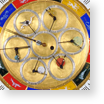A visit to the Museo Galileo concludes with the interactive area, consisting of three rooms devoted to the tangible and virtual exploration of some Galilean instruments. Here visitors can understand the experimental component of the research conducted by Galileo, an indispensable topic in a museum devoted to the great Tuscan scientist.
The first room compares ancient cosmological systems with the new celestial world discovered by Galileo. The laws of motion -from planetary motion to the fall of bodies- are illustrated as well. The second room shows the relationship between the search for longitude and the measurement of time. Ancient mechanical clocks are displayed in the third room. The whole interactive area offers visitors the chance to interact with working models and multimedia accessible on touch screens. Visitors can thus have "sensible experiences" and learn how scientific instruments work. That restores the specific purpose of objects designed to be used.
The Motion of Bodies: Time, Distances and Trajectories
The itinerary starts with two planetariums illustrating ancient concepts of cosmology. Galileo openly rejected these concepts, especially after his sensational ...
(8 objects)
Time and Space
Basically, longitude is calculated by measuring time and observing astronomical phenomena. Galileo tried to solve this problem by observing the motion ...
(6 objects)
Ancient mechanical clocks
Five ancient turret clocks with verge or anchor escapements and pendulum regulator are displayed here.One of the great masterpieces of Renaissance mechanical ...
(13 objects)
Solar Time
Since antiquity, the apparent motion of the Sun has been observed by means of sundials, designed to measure the passage of time over the span of the day ...












